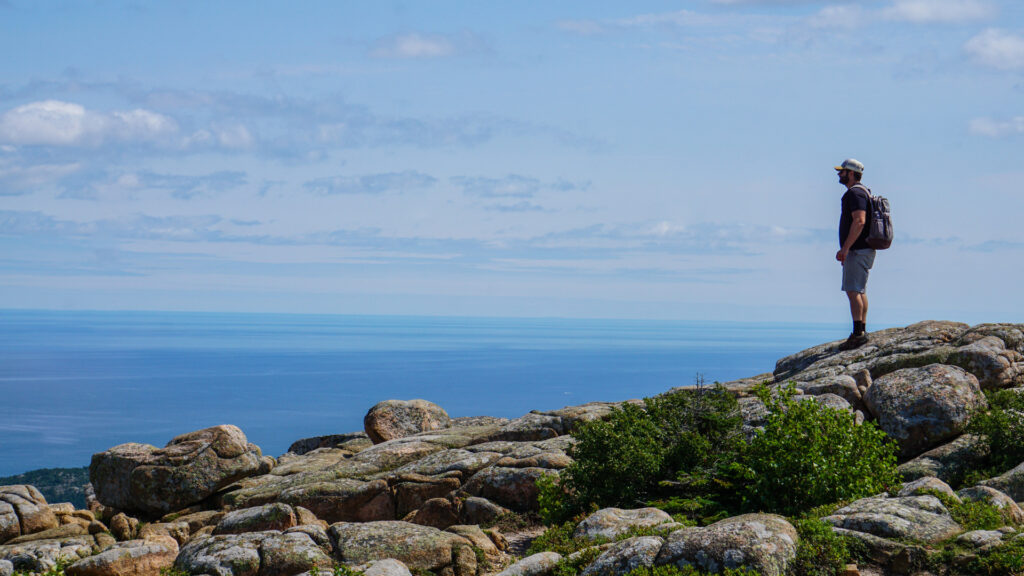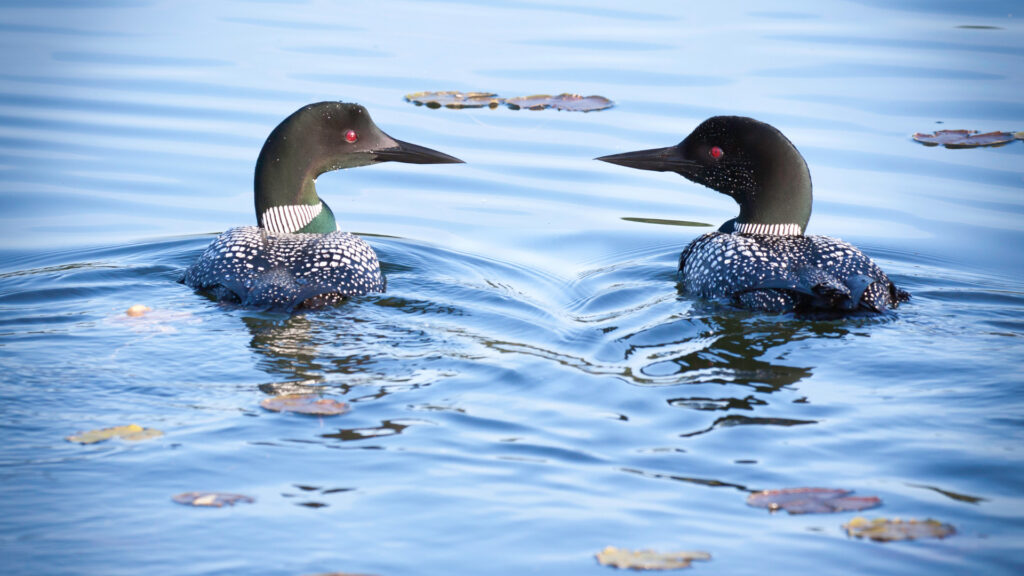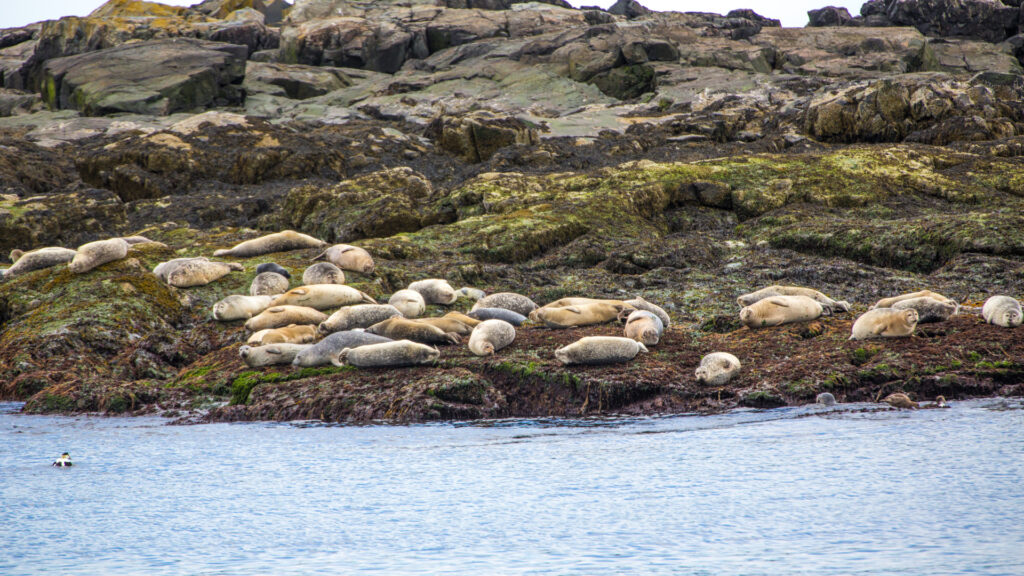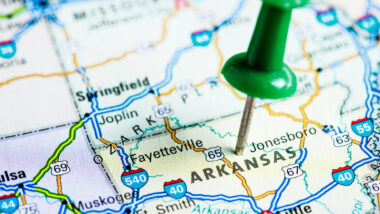Table of Contents Show
Nestled along the coastline of Maine, Acadia National Park sits about 50 miles from Bangor. Many people enjoy hiking, biking, kayaking, scenic driving, and boat touring here. Acadia National Park wildlife also adds to the Maine experience.
Whether you’re hiking to the top of Cadillac Mountain, driving along Park Loop Road, biking a carriage road, or walking through the tide pools at the Schoodic Peninsula, you’ll find wildlife unique to this region. Let’s dive in and look at what you might see during your visit!
About Acadia National Park
Known as the “Crown Jewel of the North Atlantic,” Acadia National Park is one of the most-visited national parks in the country, with over four million visitors each year. This unique park in Maine protects Mount Desert Island’s history, culture, and natural beauty.
There are 27 miles of historic motor roads, 158 miles of hiking trails, and 45 miles of carriage roads where guests can enjoy scenic driving, hiking, biking, and horseback riding.
Cadillac Mountain is a hot spot for visitors to watch one of the first sunrises in the United States. Jordan Pond is another popular location within Acadia National Park, where guests can dine at the only restaurant within the park boundaries and hike the trail around the lake.
On the other side of the park, Schoodic Peninsula offers visitors amazing views of the crashing waves at high tide against the rocky shoreline.
Read More: Here’s everything you need to know about Acadia National Park!

Are There Dangerous Animals in Acadia National Park?
Although there is wildlife in Acadia National Park, there’s no reason to be concerned for your safety here. This national park isn’t known for its wildlife encounters like Yellowstone, Rocky Mountain, or Everglades.
In fact, there are very few large mammals or meat-eating animals in Maine. Most of the animals you’ll see in Acadia National Park range from harmless sea mammals to soaring birds.
Watch for Acadia National Park Wildlife
Maine is a beautiful northeastern state. The wildlife in Acadia National Park adds to this stunning natural scenery. It’s not just about the breathtaking views from Cadillac Mountain, Bubble Rock, or Park Loop Drive.
The wildlife that makes the park home offers another dimension to America’s first East Coast national park. Watch out for these animals, whether on the water, on a trail, or in the car.
Loons
A common water bird in Maine is the loon. This bird has very unique calls, sounding much like a wolf howling at the moon. Its ability to vanish under the water is also one of the loon’s special traits.
They feed on fish and live around large bodies of water. Whether in Acadia or visiting local towns like Bar Harbor, Ellsworth, or Trenton, keep your eye out for loons near lakes and ponds. And keep your ears peeled for their expressive calls.

Peregrine Falcons
One of the only predators in Acadia National Park is the peregrine falcon. These massive birds are known for their speed, diving at 100 mph to attack their prey. However, in the mid-20th Century, peregrine falcons were dying out. Scientists even determined they weren’t breeding in the eastern United States anymore.
So Acadia began the Eastern Peregrine Falcon Reintroduction Program, which has been so successful that the bird is no longer on the endangered species list!
Because of this extra protection, visitors will find trails closed during the year where peregrine falcons nest. The park doesn’t want these areas disturbed. Always obey posted signs and never venture past a rope blocking a trailhead.
White-Tailed Deer
You don’t have to visit a particular area in Acadia National Park to see deer. These herbivores are everywhere. But if you’re looking for a great photo, visit the Sieur de Monts area or travel the carriage roads at dawn or dusk.
Unlike the peregrine falcon species, the white-tailed deer are plentiful in the park.
North American Beavers
With all the water in and surrounding Acadia National Park, it’s no wonder the following three animals are water-loving creatures. The North American beaver makes its home in the freshwater lakes of Acadia.
They’re typically out at dawn or dusk, but you’ll quickly recognize their dams and lodges during the day.
Seals
The rocky shores of Maine are the perfect habitats for some Acadia National Park wildlife. If you take a boat tour out of Bar Harbor, you’ll likely see harbor seals basking in the sun or diving in the water.
In the park, you can drive to Seal Harbor or Northeast Harbor in the southwestern part of Mount Desert Island to catch a seal sighting.

Harbor Porpoises
You likely won’t see a whale from Acadia National Park, but you can see another member of the whale family: the harbor porpoise. Like the seals, harbor porpoises are seen along the coastline. They travel in large groups, so when you see one, you’ll likely see more.
The Schoodic Peninsula is an ideal place to keep your eyes open for harbor porpoises. If you think you see a dolphin swimming in and out of the ocean, that’s a harbor porpoise.
Bats
Finally, many people overlook bats when viewing Acadia National Park wildlife because they don’t stay in the park at night. But bats play an integral role in the ecosystem of the park. Sadly, the bat population has decreased substantially over the years due to white-nose syndrome.
Acadia hopes to implement a plan to help save the bats, particularly the federally threatened Northern Long-eared Bat, just like they did with the peregrine falcons.
Keep in Mind: If you want to get up close and personal with bats, you need to add Carlsbad Caverns Bats to your bucket list!
Where Are the Best Locations to View Acadia National Park Wildlife?
Other than deer and squirrels, you’ll likely have to pay close attention to see other Acadia National Park wildlife. For birders, visit Cadillac Mountain in the fall to watch for hawks, travel to Otter Point to look for seabirds, and visit Jordan Pond to see loons. You’ll also likely see and hear warblers all over the island, as over 20 species breed here.
Jordan Pond is also an ideal place to search for beavers. You’ll see their handiwork as you walk the trail around the lake. You’ll also likely see white-tailed deer, barred owls, and songbirds in the Sieur de Monts area of the park. The Jesup Path is a great trail for wildlife viewing.
To find marine animals, drive to Bar Island, Schoodic Point, and Seawall and walk the Ocean Path. Finally, Precipice Trail is the perfect location to catch a peregrine falcon sighting when the trail opens. Acadia also offers ranger-led programs to learn more about the fastest animal in the world.
Can I see a Moose in Acadia National Park?
Although moose live in Maine, they don’t live in Acadia National Park. A moose sighting is very rare. Your best bet to see a moose is to head north to Katahdin Woods and Waters National Monument.
Some of Maine’s state parks will also offer better opportunities to see these giant creatures.
Are There Ranger Programs About Acadia National Park Wildlife?
One of the best ways to experience a national park is to attend a ranger program. These programs are often less than 30 minutes but offer insight into the history, geology, habitats, and ancestral peoples of our national treasures.
You can learn more about Acadia National Park wildlife by attending a campfire talk at one of the campgrounds, joining a ranger on a guided walk along one of the park trails, or parking at the Precipice trailhead lot for the Peregrine Falcon Watch Program.
Guests can take a boat tour around Acadia National Park to watch for seabirds and marine mammals and learn about lighthouse history and early homesteaders. In addition, kids can become Junior Rangers by completing activities like visiting the Sieur de Monts Nature Center or attending the Schoodic District Touch Tank Talks.
Spot the Diverse Wildlife of Acadia National Park
Acadia National Park wildlife is unique. From soaring birds to sea life, there’s a little bit of everything here. You won’t find the “big” mammals visitors hope to see in national parks, like bison, grizzly bears, elk, or moose.
But that doesn’t mean the wildlife in Acadia disappoints. Listen for the calling loons early in the morning, look high for peregrine falcons zipping through the sky, and scan the ocean for fins and tails of seals and porpoises.
Among the tide pools, you’ll see even more marine life, from sea stars to tadpoles to snails to barnacles. So head out to Bar Island, the Schoodic Peninsula, or Ship Harbor for a few hours of fun while the tide is low.
What will you see when you visit Acadia National Park?






